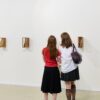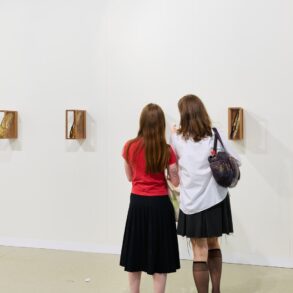Georgetown University’s Maria & Alberto de la Cruz Gallery was once the Hall of Nations, which hosted a 1979 concert that catalyzed the local hardcore punk scene. There’s a curious echo of that history in the gallery’s current show, “Confluences: Intersectional Visions of Italy.” The wordy artworks by a diverse group of Italian women include pages from Italian music fanzines published from 1978 to 2006 and compiled by Dafne Boggeri into a book. Among the performers featured are D.C. punks Government Issue and Henry Rollins.
The names of Washington musicians are not the show’s only global connections. In Muna Mussie’s video, Black hands trace textbook exercises in Tigrinya, the ancestral language she didn’t master because her family moved from Eritrea to Italy when she was 2. Maria Adele Del Vecchio emblazons shawls, most of them originally her mother’s, with phrases from books in Italian and English, one of them a Toni Morrison novel. Also in English is Alessandra Ferrini’s scrawled commentary on archival material about Mussolini-era Italian colonialism, notably Italy’s occupation of the land where Mussie was born.
“We break the silence to speak the unspeakable,” proclaims a placard in Valeria Cherchi’s installation, which addresses the unsolved 2003 murder of a young woman in her native Sardinia. An image upstages the many words of this piece, which features multiple versions of the same photo of a young woman, her face framed by a lacy white hood traditional on the island. In one version of the picture, the woman’s pupils are missing, as if to indicate the unspeakable is unseeable as well.
The least text-driven piece is Binta Diaw’s installation, which places a photograph of the Senegalese-Italian artist’s neck and shoulders above a mound of earth. Three-dimensional braids emerge from the photo to link it to the earth, and the picture is positioned so that Diaw’s head seems to be buried in the soil. Diaw was born in Milan but is rooted somewhere else — in a continent that, as “Confluences” demonstrates, has a complex relationship to Italy.
Confluences: Intersectional Visions of Italy Through April 7 at Maria & Alberto de la Cruz Gallery, Georgetown University, 3535 Prospect St. NW. delacruzgallery.org. 202-687-8039.
Lisa Marie Thalhammer
Best known as an outdoor muralist, Lisa Marie Thalhammer was instrumental in creating the gallery of wall and door paintings in Washington’s Blagden Alley — recently seen in Tsai Ming Liang’s “Abiding Nowhere,” a meditative film commissioned by the National Museum of Asian Art. Thalhammer, who now divides her time between D.C. and her native St. Louis, is an LGBTQ+ activist whose rainbow-colored “Love” mural in Blagden Alley echoes the hues of the Pride flag. The artist has taught yoga, and she references the color system of chakras (supposed focal points within the body used for meditation). These inspirations wheel through “Chromatic Dialogue,” Thalhammer’s show at the University of Maryland Art Gallery.
The selection includes photographs of several Thalhammer outdoor projects, including her “Equilateral Network” of interlocking multicolor triangles painted on the National Building Museum lawn in 2021. There’s also a version of the “Love” design rendered in glittery pigment. Ever the muralist, Thalhammer painted a rainbow of large vertical stripes directly on two perpendicular walls, with green at the corner where the planes meet.
Less expected and more kinetic are pictures in which Thalhammer lets colors flow by chance. Two paintings were made with strings dipped in pigment and swirled across the surface. The show’s centerpiece is a triptych that shifts as usual from red to yellow to blue, but the colors are cascades of drips deepened by blacks and brightened by flashes of white. While the procession of colors is foregone, each of the gestures is alive with spontaneity.
Lisa Marie Thalhammer: Chromatic Dialogue Through April 5 at the Art Gallery, Parren J. Mitchell Art-Sociology Building; University of Maryland, College Park. artgallery.umd.edu. 301-405-2763.
Prina Shah
Color cycles and ancient Indian teachings also underlie Prina Shah’s mixed-media paintings, whose intricate details revolve in hundreds of concentric circles. Shah’s Morton Fine Art show, “The Unseen,” includes ink-and-graphite drawings that employ the same format but just one or two hues. All the pictures were made by Shah in her homeland, Kenya, where she was born to Indian parents.
The paintings are in multiple colors, but these usually appear to merge into a dominant overall hue. A profusion of delicate gestures are arrayed atop a solid black circle, but the bottom layer is barely visible beneath the markings. These include spirals of English-language text that’s mostly unreadable, because the words are usually overwritten with other ones. The writing was done with a pen normally used to make henna patterns on skin.
The result is dense and eventful, yet concealing. “The Unseen” refers to the “energy body” within the human form, an idea closely related to chakras. But Shah’s representation of invisible depths also produces luxuriant surfaces, spinning with visible animation.
Prina Shah: The Unseen Through April 17 at Morton Fine Art, 52 O St. NW, #302. mortonfineart.com. 202-628-2787.
Sandra Dooley
In Sandra Dooley’s “Champions,” seven girl swimmers hold flowers, a trophy and a kitten over their heads in gestures of triumph. It’s a multiracial group, with skin tones that include brown, pink and marine blue. Naturalistic and unnatural colors intermingle to embody the character of the artist’s homeland, Cuba. It’s a place whose “Layers,” the title of Dooley’s Amy Kaslow Gallery show, encompass diversity, ingenuity and magical realism.
Dooley has a naive style that’s complicated intriguingly by incorporating recycled and repurposed elements. Most often, she portrays women who gaze forthrightly at the viewer through prominent eyes. Sometimes their irises are made of buttons, which the artist also uses to represent other body parts, including breasts and a corona of pink curls framing a round yellow face. Bits of fabric also figure in many of the collage-paintings, some of which depict costumes for Cuba’s national ballet company.
Dooley uses money she earns from selling her art to feed community cats and dogs in her beachfront neighborhood near Havana. These and other creatures appear in many of her pictures, notably a collagraph in which a cat wraps tightly around a woman’s neck. Heavy on metallic pigments, Dooley’s prints feature copper backgrounds and bronze and silver hair. That’s just one of the ways the artist uses unexpected hues and textures to transfigure everyday subjects.
Sandra Dooley: Layers Through April 7 at Amy Kaslow Gallery, 7920 Norfolk Ave., Bethesda. amykaslowgallery.com. (no phone number listed)
This post was originally published on this site be sure to check out more of their content







